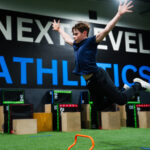Speed and Agility Training for Goalkeepers
Goalkeepers play a unique role in sports like soccer and hockey. They need elite reflexes, explosive lateral movement, and the ability to change direction in a split second. Traditional field or ice training doesn’t fully prepare keepers for the fast, reactive demands of their position.
That’s where speed and agility training comes in.
In this article, you’ll discover how to design and execute a specialized speed and agility training routine that helps goalkeepers dominate the box, crease, or net.
Why Goalkeepers Need Specific Speed and Agility Work
Goalkeepers aren’t just defenders—they’re reactors, decision-makers, and athletes who move explosively in short spaces.
Here’s what sets their speed and agility demands apart:
1. Lateral Quickness
Most keeper movements are side-to-side. Sprinting in straight lines matters less than fast shuffles and dives.
2. Explosive Bursts
Diving for a save, jumping for a cross, or sprinting off the line all demand single-step explosiveness.
3. Reaction Speed
Goalkeepers often have less than 0.5 seconds to respond to a shot or redirect. They need their brain and body connected.
4. Balance and Control
Every save ends in an awkward position. Agility training helps keepers recover quickly and stay in play.
According to the NSCA, sport-specific agility drills help athletes react more effectively under pressure—perfect for high-stakes goalkeeping.
Key Components of Goalkeeper Agility Training
To train like an elite keeper, focus on:
✅ Short Burst Acceleration
1–3 step sprints are more common than long-distance runs.
✅ Deceleration and Control
Training how to stop and change direction safely is just as vital as speed itself.
✅ Low Stance Movement
Staying in a ready, crouched position requires strong hips and balance.
✅ Reactive Cues
Incorporate lights, sounds, or partner signals to replicate in-game unpredictability.
Best Speed and Agility Drills for Goalkeepers
Here are keeper-specific drills that build explosive reaction time, quick feet, and full-body control.
1. Lateral Shuffle and Dive Drill
How:
-
Set up two cones 4–6 feet apart.
-
Shuffle laterally between them.
-
At a cue, dive to touch a low ball or pad.
Focus: Lateral speed, reaction, and full-body control
Reps: 3–4 rounds of 20 seconds
2. Reaction Ball Drop
How:
-
Partner stands on a box or chair and drops a reaction ball.
-
Keeper must sprint and catch it before second bounce.
Focus: Quick acceleration and visual reaction
Reps: 3 sets of 5 drops each
3. T-Drill for Goalkeeper Movement
How:
-
Set cones in a T-shape.
-
Start at the base, sprint to the top, shuffle laterally, return.
Focus: Forward sprint, lateral agility, backpedal
Reps: 3–4 sets with full recovery
4. Goal Line Side Shuffle with Save
How:
-
Set up cones along the goal line.
-
Shuffle left and right.
-
Coach or partner tosses a ball or gives a dive cue.
Focus: Anticipation and agility in small zones
Reps: 3–5 reps with 30 seconds rest
5. Medicine Ball Toss and React
How:
-
Stand in low stance.
-
Partner tosses a ball randomly to the left or right.
-
Dive, catch, and return.
Focus: Power, balance, and timing
Reps: 3–4 sets of 8–10 reps
Weekly Goalkeeper Speed and Agility Schedule
Here’s a sample training plan tailored for keepers:
Monday – Lateral Focus
-
Warm-up jog, mobility
-
Lateral shuffle and dive – 4 rounds
-
Cone slalom shuffle – 3 sets
-
Low stance hold with side hops – 3 rounds of 20 seconds
-
Core finisher: Plank to push-up
Wednesday – Reaction and Explosiveness
-
Reaction ball drop – 3 sets
-
T-Drill – 4 rounds
-
Medicine ball dive toss – 4 sets
-
Sprint and backpedal circuit – 3 rounds
-
Cool-down + static stretching
Friday – Game Simulation
-
Side shuffle with save cue – 4 rounds
-
Mirror drill with partner – 3 sets
-
Goal line movement with toss – 3 sets
-
Sprint-stop-return sprints – 5 reps
-
Breathing reset + mobility work
Equipment Tips for Keeper Drills
Training is easy with just a few pieces of gear:
-
Cones or discs for marking
-
Medicine ball for reactive drills
-
Reaction ball or tennis ball
-
Agility ladder (for foot speed)
-
Resistance bands (for deceleration strength)
These tools help replicate save scenarios while building explosiveness and reaction under fatigue.
Mistakes to Avoid in Goalkeeper Agility Training
-
Overemphasizing straight-line speed: Sprinting isn’t a keeper’s priority. Focus on lateral and reaction-based drills.
-
Neglecting recovery: Goalkeeping demands explosive movements. Give muscles time to rebuild and avoid injury.
-
Skipping cues: Don’t make every drill predictable. Add light, sound, or voice commands for realism.
-
Ignoring hand speed: Use tennis balls or resistance drills to train fast hand reactions—not just footwork.
Build Better Goalkeeping at Next Level
At Next Level Athletics USA, we build specialized agility programs for goalkeepers who want to dominate their position. Our customized workouts combine elite reaction training with position-specific movement to help keepers level up fast.
Whether you’re defending the net in soccer or hockey, we help you stay sharp under pressure.
Final Thoughts
Great goalkeepers don’t just block shots—they anticipate them. They react faster, move smarter, and recover better than their competition.
Speed and agility training tailored for goalkeepers builds the exact skills needed to save more and concede less. With short bursts, reactive drills, and lateral quickness work, you’ll become more explosive and consistent in the net.
Train like every shot counts—because it does.


Recent Comments